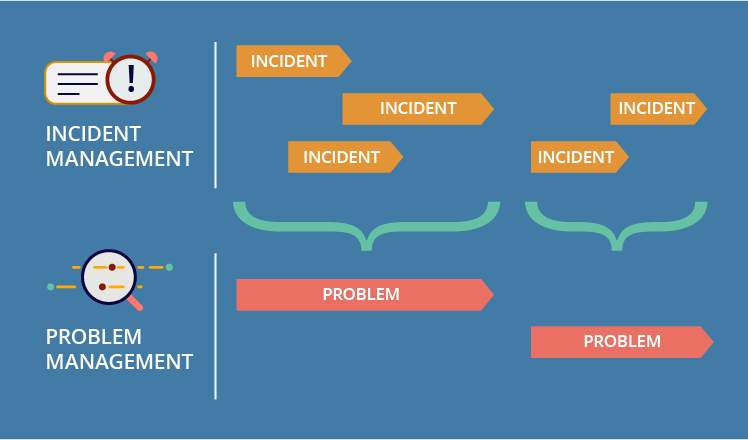What Is the Point of ServiceNow® Platform Problem Management?
The ITSM system is up and running, however IT specialists are struggling to cope with the flood of similar incidents and fix them over and over again. Does the situation described look familiar? If yes, then ServiceNow consulting practitioners recommend considering problem management in addition to already familiar incident management. In the article, we explore problem management within the framework of ServiceNow – a leader on the ITSM market. Also, you can see an example of ServiceNow problem management in our interactive demo.
To be on the same page, let’s stick to the definitions from ITIL v3:
An incident is an unplanned interruption in service or loss of quality.
A problem is a cause of one or more incidents.
Incident management is the process of managing the lifecycle of incidents.
Problem management is the process of managing the lifecycle of all problems that happen or could happen in an IT service.

An example of when ServiceNow problem management fits in
Let’s imagine a situation: an employee could not access the ERP system. He/she created an incident, which IT specialists soon fixed. A daily workflow was restored, but precious time was lost. The consequences could have been even worse: say, the employee had to prepare a report for a management meeting, or make an informed decision based on the data from the system, etc. But that was not the end of the story. The next morning, and the day after, everything repeated, and not only with this employee, but with some of the colleagues as well.
This example gives a clear idea of how the situation develops if the company practices only incident management. Besides, if IT specialists have a number of incidents as their KPI, they might focus on processing the incidents, without trying to identify and fix the root causes.
It goes without saying that incident management is important. However, the ability to define a root cause through structured problem analysis followed by documenting solutions and workarounds in the knowledge base allows solving deeper problems systematically. This means that problem management software helps reduce the quantity of incidents, which improves workflow efficiency.
In addition to a reactive approach, when IT specialists identify and aim to solve the problems leading to the incidents that have already happened, a proactive approach is also possible. In other words, problem management allows defining and solving a problem well in advance, before it causes any incident.
Problem management challenges solved with ServiceNow
There is hardly any process with no challenges to solve. Let’s discuss what challenges exist in problem management procedure and how they are addressed in ServiceNow.
Investing additional efforts
A business has to invest efforts to set up a process flow for problem management. When this is done, IT team will have to continuously analyze every incident and link it to a problem. Will these efforts pay off? Searching for an answer, compare these efforts with those needed to fix recurring similar incidents. If configured properly, ServiceNow helps to reduce the number of incidents, and consequently, increase efficiency, improve service quality and enhance user satisfaction.
Binding incidents to a problem
Finding a relevant problem is a challenge. Besides, what if a problem manager or a service specialist overlooked an existing problem and created a duplicate? Should the team spend extra efforts to solve the same problem twice? ServiceNow has automated tools (for instance, BSM Visualization and CMDB baseline history) based on algorithms and business rules that help to avoid duplicates by prompting the existing problems or known errors from the database.
Identifying when to create a problem
When to create a problem: after an incident is solved or when several similar incidents have occurred? And how to understand that the incidents are similar? In ServiceNow, a problem can be created while an incident is being fixed or after the incident is solved. To understand that the incidents are similar, a combination of approaches can be used: experience and competence of the IT team, agile search in the Known Error Database and Configuration Management Database, as well as automated tools like BSM Visualization. There is no problem if different IT specialists process incidents, as while typing a problem description they can check whether there is any related information in the knowledge base.
To sum it up
ITIL problem management is a step beyond incident management. The process aims to manage the life cycle of problems. Thanks to problem management, a company gains such benefits as increased efficiency, minimized negative effects and enhanced user satisfaction. In addition, the process allows a proactive approach, aimed at preventing incidents.
Although some problem management challenges exist, for example, investing additional efforts, binding incidents to a problem and identifying when to create a problem, ServiceNow provides the capabilities to solve them.

